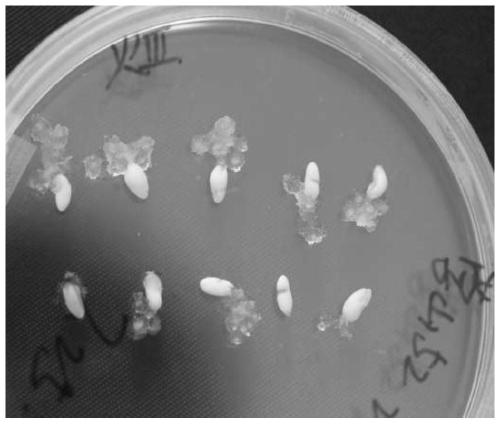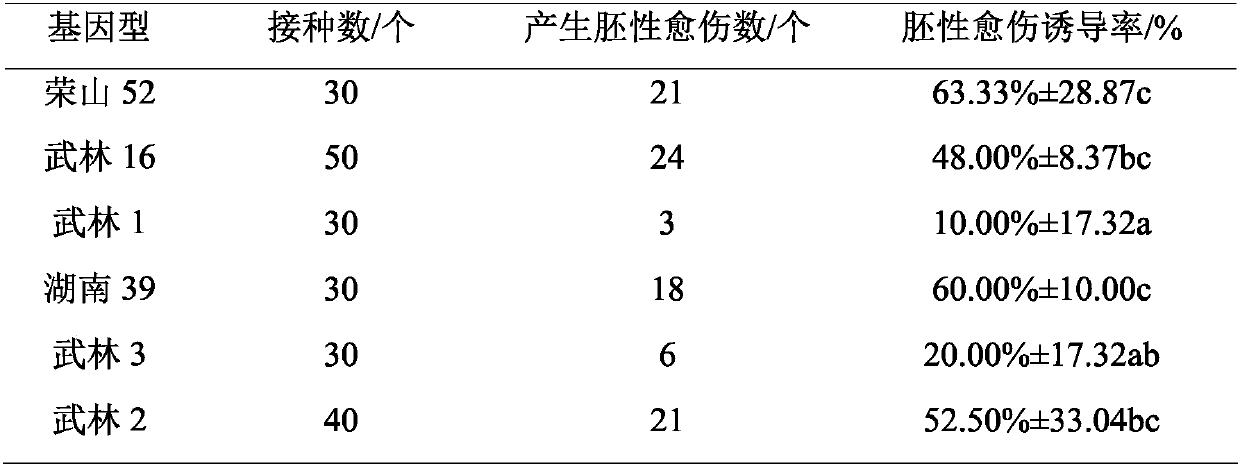Method for inducing loblolly pine embryonic callus, and dedicated culture medium thereof
An embryogenic callus and induction medium technology, applied in the field of plant tissue culture, can solve the problems of high cost, low efficiency, and difficulty in meeting production requirements, and achieve the effects of good embryogenicity, high efficiency, and improved yield and quality.
- Summary
- Abstract
- Description
- Claims
- Application Information
AI Technical Summary
Problems solved by technology
Method used
Image
Examples
Embodiment 1
[0023] A method for inducing embryogenic callus of pine taeda, comprising the following steps:
[0024] 1. Collection of Explants
[0025] In mid-to-late July, take natural pollinated immature cones from the middle and upper periphery of the canopy of the taeda pine mother plant with good growth, no pests and diseases, and a large amount of fruit in the 1st generation seed garden of taeda loblolly, and bring them back to the laboratory 4 ℃ refrigerator on the day of collection save.
[0026] 2. Disinfection of explants
[0027] Take the immature taeda pine cones out of the refrigerator, peel off the immature seeds with branch shears, remove the seed wings and place them in a sterile inoculation bottle, and then put them on the ultra-clean workbench for disinfection. Disinfect with 75% alcohol for 30 seconds, rinse with sterile water for 3-5 times, then soak in 0.1% mercury liter for 7-8 minutes, shake the bottle continuously for 5-6 times, rinse with sterile water for 5-7 ti...
Embodiment 2
[0033] Example 2 Effects of different genotypes on the induction of embryogenic callus of Pine taeda
[0034] According to the operation method of Example 1, the collected explants of 6 different genotypes such as Rongshan 52 were placed on the induction medium for embryogenic callus induction, and 10 callus were inoculated in each dish. The induction results are shown in Table 1.
[0035] Table 1 Effect of different genotypes on induction of embryogenic callus
[0036]
[0037] It can be seen from Table 1 that there are significant differences in the induction rate of embryogenic callus among different genotypes. The highest induction rate of embryogenic callus is Rongshan 52, with an average induction rate of 63.33%, and the lowest is Wulin 1. The induction rate was only 10%, and there were significant differences in the induction rate of embryogenic callus among different genotypes, indicating that genotype is one of the important factors affecting embryogenic callus.
Embodiment 3
[0038] Example 3 Effects of different basal mediums on the induction of embryogenic callus of Pine taeda
[0039] According to the operation method of Example 1, the explants were inoculated into 6 different basal media such as LP, DCR, mWV5, LV, B5 and WPM for induction, and 1.0 mg·L -1 2,4-D, 0.5mg·L -1 6-BA, 500mg·L -1 Inositol, 450mg·L - 1 L-Glutamine, 500mg·L -1 Hydrolyzed casein, 30g·L -1 Sucrose and 7.5g·L -1 Table 1 shows the effects of carrageenan and different basal media on the induction of embryogenic callus.
[0040] The results in Table 2 show that the induction rate of embryogenic callus in DCR medium is the highest, reaching 34.00%; followed by WPM and LP medium, the induction rate of embryogenic callus is 15.00% and 10.00% respectively; while LV, mMV5 and The induction rate in B5 medium was low, and there was a significant difference between DCR medium and other media, indicating that basal medium was very important for inducing embryogenic callus.
[...
PUM
 Login to View More
Login to View More Abstract
Description
Claims
Application Information
 Login to View More
Login to View More - R&D
- Intellectual Property
- Life Sciences
- Materials
- Tech Scout
- Unparalleled Data Quality
- Higher Quality Content
- 60% Fewer Hallucinations
Browse by: Latest US Patents, China's latest patents, Technical Efficacy Thesaurus, Application Domain, Technology Topic, Popular Technical Reports.
© 2025 PatSnap. All rights reserved.Legal|Privacy policy|Modern Slavery Act Transparency Statement|Sitemap|About US| Contact US: help@patsnap.com



